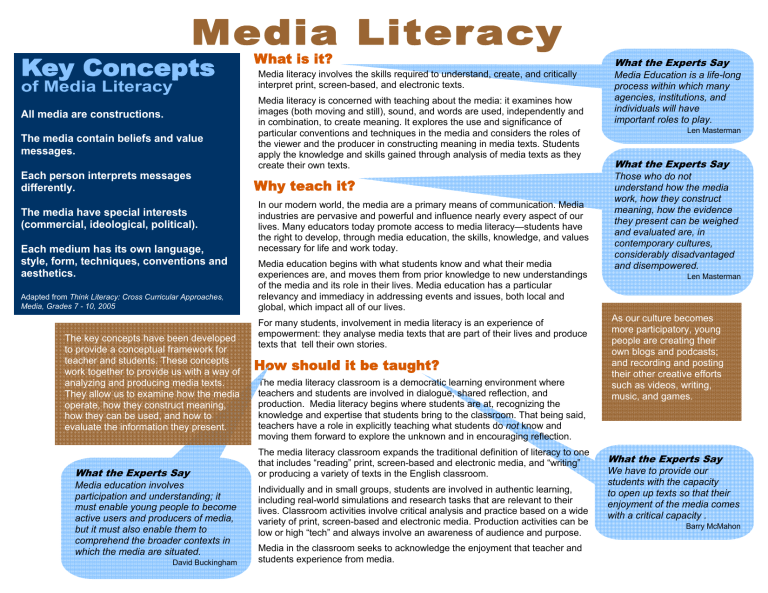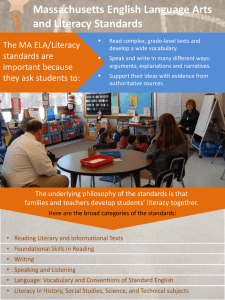
Media Literacy Key Concepts of Media Literacy All media are constructions. The media contain beliefs and value messages. Each person interprets messages differently. The media have special interests (commercial, ideological, political). Each medium has its own language, style, form, techniques, conventions and aesthetics. Adapted from Think Literacy: Cross Curricular Approaches, Media, Grades 7 - 10, 2005 The key concepts have been developed to provide a conceptual framework for teacher and students. These concepts work together to provide us with a way of analyzing and producing media texts. They allow us to examine how the media operate, how they construct meaning, how they can be used, and how to evaluate the information they present. What the Experts Say Media education involves participation and understanding; it must enable young people to become active users and producers of media, but it must also enable them to comprehend the broader contexts in which the media are situated. David Buckingham What is it? Media literacy involves the skills required to understand, create, and critically interpret print, screen-based, and electronic texts. Media literacy is concerned with teaching about the media: it examines how images (both moving and still), sound, and words are used, independently and in combination, to create meaning. It explores the use and significance of particular conventions and techniques in the media and considers the roles of the viewer and the producer in constructing meaning in media texts. Students apply the knowledge and skills gained through analysis of media texts as they create their own texts. Why teach it? In our modern world, the media are a primary means of communication. Media industries are pervasive and powerful and influence nearly every aspect of our lives. Many educators today promote access to media literacy—students have the right to develop, through media education, the skills, knowledge, and values necessary for life and work today. Media education begins with what students know and what their media experiences are, and moves them from prior knowledge to new understandings of the media and its role in their lives. Media education has a particular relevancy and immediacy in addressing events and issues, both local and global, which impact all of our lives. For many students, involvement in media literacy is an experience of empowerment: they analyse media texts that are part of their lives and produce texts that tell their own stories. How should it be taught? The media literacy classroom is a democratic learning environment where teachers and students are involved in dialogue, shared reflection, and production. Media literacy begins where students are at, recognizing the knowledge and expertise that students bring to the classroom. That being said, teachers have a role in explicitly teaching what students do not know and moving them forward to explore the unknown and in encouraging reflection. The media literacy classroom expands the traditional definition of literacy to one that includes “reading” print, screen-based and electronic media, and “writing” or producing a variety of texts in the English classroom. Individually and in small groups, students are involved in authentic learning, including real-world simulations and research tasks that are relevant to their lives. Classroom activities involve critical analysis and practice based on a wide variety of print, screen-based and electronic media. Production activities can be low or high “tech” and always involve an awareness of audience and purpose. Media in the classroom seeks to acknowledge the enjoyment that teacher and students experience from media. What the Experts Say Media Education is a life-long process within which many agencies, institutions, and individuals will have important roles to play. Len Masterman What the Experts Say Those who do not understand how the media work, how they construct meaning, how the evidence they present can be weighed and evaluated are, in contemporary cultures, considerably disadvantaged and disempowered. Len Masterman As our culture becomes more participatory, young people are creating their own blogs and podcasts; and recording and posting their other creative efforts such as videos, writing, music, and games. What the Experts Say We have to provide our students with the capacity to open up texts so that their enjoyment of the media comes with a critical capacity . Barry McMahon Key Concepts of Media Literacy Public Service Announcement (PSA) Example All media are constructions Media contain ideological and values messages Media construct meaning through a combination of elements: images, sounds, graphics, and words. Conscious decisions informed the construction of this advertisement. The images of clothing and the sunscreen bottle, the language in the text, the placement and design are all crafted in order to communicate meaning in an appealing way to its target audience. All media present beliefs, values, opinions, and biases. Generally, these are held by the producers of the media, and the media text, in turn, articulates these to consumers. In this case, the Canadian Cancer Society uses the ad to inform and educate the public on the benefits of using sunscreen. The ad uses an authoritative point of view and prevention education that targets, primarily, young families and health-conscious individuals. How is this media text constructed? Who is it for? What meaning is being constructed? What lifestyles, values, and points of view are represented in this media text? Whose voice is absent? What information is omitted? Media have commercial implications Generally, media are intended to benefit the interests of both the consumer and the producer of the media. All advertising sells something. This public service announcement (PSA) sells advice intended for the public good: the importance of using sunscreen protection. Consumers benefit from the information provided in the PSA. The Canadian Cancer Society, the ad’s producer, benefits by being seen as an advocate and promoter of this healthy life choice (not of a specific sunscreen product). Who created this ad and for what purpose? Who benefits from this ad being in the public? What techniques are used and why? How do the characteristics shape the meaning? How effective are the techniques in supporting the messages in the text? Each person interprets messages differently Even though a media producer creates media to communicate certain messages, each consumer interprets the media text differently, based on his or her values and experiences. Individuals who have been sunburned, those who have not, adults responsible for children, and children all respond differently to this advertisement. Each medium has a its own language, style, form, techniques, conventions, and aesthetics Some techniques used in some media to create meaning may not be possible in others. The technique of fading to black, for example, is an effect used in movies, television, or computer images, but it is not an option for hard-copy texts. In this advertisement, text, still images, and space are used to communicate its message. The font of the slogan sidebar ‘Sunsense’ is playful. This playfulness is also evident in the images of children’s beach wear, and the swirl sun graphic on the T-shirt and sunscreen bottle. The alliteration of the interjections, ‘Slip! Slap! Slop!, makes the phrase catchy and memorable All of these characteristics support the message that protecting skin is part of the fun. What meaning do I get from the media text? What are some other interpretations people might take? Why might some people take a different meaning from this text? Advertisement used with permission of Canadian Cancer Society. Content on media adapted from Think Literacy: Cross Curricular Approaches, Grades 7 - 12, Subject Specific Examples: Media, Grades 7-10, 2005.





